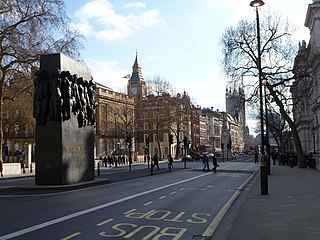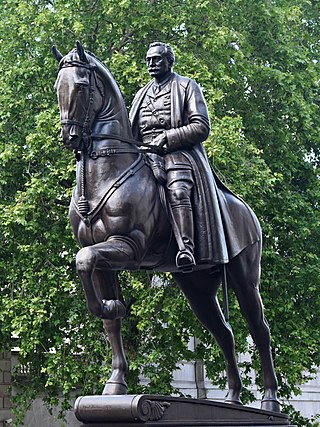
Whitehall is a road and area in the City of Westminster, Central London, England. The road forms the first part of the A3212 road from Trafalgar Square to Chelsea. It is the main thoroughfare running south from Trafalgar Square towards Parliament Square. The street is recognised as the centre of the Government of the United Kingdom and is lined with numerous departments and ministries, including the Ministry of Defence, Horse Guards and the Cabinet Office. Consequently, the name "Whitehall" is used as a metonym for the British civil service and government, and as the geographic name for the surrounding area.

An equestrian statue is a statue of a rider mounted on a horse, from the Latin eques, meaning 'knight', deriving from equus, meaning 'horse'. A statue of a riderless horse is strictly an equine statue. A full-sized equestrian statue is a difficult and expensive object for any culture to produce, and figures have typically been portraits of rulers or, in the Renaissance and more recently, military commanders.

Earl Lloyd-George of Dwyfor is a title in the peerage of the United Kingdom. It was created in 1945 for Liberal parliamentarian David Lloyd George who served as Chancellor of the Exchequer from 1908 to 1915 and Prime Minister of the United Kingdom from 1916 to 1922. He was created Viscount Gwynedd, of Dwyfor in the County of Caernarvon, also in the Peerage of the United Kingdom, at the same time.

Horse Guards Parade is a large parade ground off Whitehall in central London. It is the site of the annual ceremonies of Trooping the Colour, which commemorates the monarch's official birthday, and the Beating Retreat.

Field Marshal Frederick Sleigh Roberts, 1st Earl Roberts, was a British Victorian era general who became one of the most successful British military commanders of his time. Born in India to an Anglo-Irish family, Roberts joined the East India Company Army and served as a young officer in the Indian Rebellion during which he was awarded the Victoria Cross for gallantry. He was then transferred to the British Army and fought in the Expedition to Abyssinia and the Second Anglo-Afghan War, in which his exploits earned him widespread fame. Roberts would go on to serve as the Commander-in-Chief, India before leading British Forces for a year during the Second Boer War. He also became the last Commander-in-Chief of the Forces before the post was abolished in 1904.
Events from the year 1805 in the United Kingdom. This is the year of the Battle of Trafalgar.

The Earl Haig Memorial is a bronze equestrian statue of the British Western Front commander Douglas Haig, 1st Earl Haig on Whitehall in Westminster, London. It was created by the sculptor Alfred Frank Hardiman and commissioned by Parliament in 1928. Eight years in the making, it aroused considerable controversy; the Field Marshal's riding position, his uniform, the horse's anatomy and its stance all drew harsh criticism. The inscription on the plinth reads 'Field Marshal Earl Haig Commander-in-Chief of the British Armies in France 1915–1918'.

David Morier, was an Anglo-Swiss painter of portraits, military subjects and historical scenes around and after the time of the War of the Austrian Succession and the related Jacobite rising of 1745.

The Guards Memorial, also known as the Guards Division War Memorial, is an outdoor war memorial located on the west side of Horse Guards Road, opposite Horse Guards Parade in London, United Kingdom. It commemorates the war dead from the Guards Division and related units during the First World War, and of the Household Division in the Second World War and other conflicts since 1918.

The statue of the Earl Kitchener is an outdoor bronze statue by John Tweed depicting Herbert Kitchener, 1st Earl Kitchener, installed in 1926 and located on the south side of Horse Guards Parade in London, United Kingdom. The sculpture stands on a Portland stone plinth. It became a Grade II listed building in 1970.

The equestrian statue of the Viscount Wolseley is an outdoor sculpture depicting Garnet Wolseley, 1st Viscount Wolseley, located at the Horse Guards Parade in London, United Kingdom. It is by Sir William Goscombe John and was unveiled by the Duke of Connaught in 1920. The front of the plinth contains an inscription which reads "Wolseley", while the back includes the inscription: "Field-Marshal Viscount Wolseley, KP, GCB, OM, GCMG, 1833–1913, Commander-in-Chief of the British Army, 1895–1900. / Burmah 1852–3 / Crimea 1854–5 / Indian Mutiny 1857–9 / China 1860–1 / Red River 1870 / Ashanti 1873–4 / South Africa 1879 / Egypt 1882 / Soudan 1884–5."

A bronze statue of Admiral of the Fleet Louis Mountbatten, 1st Earl Mountbatten of Burma is located on Mountbatten Green, off Horse Guards Road, Whitehall, London, England. The sculptor was Franta Belsky and the work was cast by the Meridian Bronze Foundry. The memorial was unveiled on 2 November 1983.

The Cavalry of the Empire Memorial, also known as the Cavalry Memorial, is a war memorial in Hyde Park, London. It commemorates the service of cavalry regiments in the First and Second World Wars. It became a Grade II listed building in 1987, and was promoted to Grade II* in November 2014.

The Thames Ditton Foundry was a foundry in Thames Ditton, Surrey, which operated from 1874 to 1939 and which under various owners produced numerous major statues and monuments as one of the United Kingdom's leading firms of bronze founders.

Lieutenant Colonel Sir John Mansel Miller, was a British Army officer and equestrian who served as Crown Equerry to Queen Elizabeth II from 1961 to 1987.

The Stonewall Jackson Monument in Richmond, Virginia, was erected in honor of Thomas Jonathon "Stonewall" Jackson, a Confederate general. The monument was located at the centre of the crossing of Monument Avenue and North Arthur Ashe Boulevard, in Richmond, Virginia. The bronze equestrian statue was unveiled in 1919. Along this avenue were other statues including Robert E. Lee, J. E. B. Stewart, Jefferson Davis, Matthew Maury and more recently Arthur Ashe. Thomas Jackson is best known as one of Robert E. Lee's most trusted commanders throughout the early period of the American Civil War between Southern Confederate states and Northern Union states. He rose to prominence after his vital role in the Confederate victory at the First Battle of Bull Run in July 1861, continuing to command troops until his untimely death on May 10, 1863, after falling fatally ill following the amputation of his wounded arm.

An equestrian statue of Charles II trampling Cromwell stands near Newby Hall in North Yorkshire, England. It was previously sited at Gautby Hall in Lincolnshire, and was originally installed at the Stocks Market in the City of London. It is a Grade II listed building.

The 2022 Trooping the Colour ceremony was held on Thursday 2 June 2022, as part of the Platinum Jubilee celebrations of Queen Elizabeth II. Over 1,400 parading soldiers, 200 horses, and 400 musicians came together in the traditional parade to mark the Queen's Official Birthday, which usually takes place on the second Saturday of June. It was the final Birthday Parade to take place under the reign of Elizabeth II before her death on 8 September later that year.


















